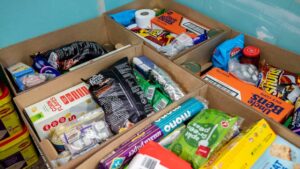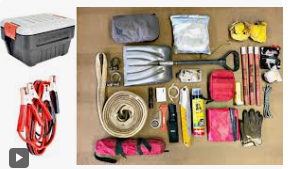 Please read the first part of this article.
Please read the first part of this article.
 Food
Food
This category is the most challenging. You have to make sure that:
- The expiration dates on any food are adequate for your goal (shelf life).
- The ingredients do not contain harmful chemicals, additives, or too much salt (care about nutrition).
- You have to prepare a variety of food. Don’t just settle for beans and rice, as some survival websites suggest. Instead, opt for a variety of foods, including beans, rice, fruits, vegetables, meats, and proteins, among others.
- The food tastes satisfactory, and it is nutritious enough.
- You should get at least 2,500 – 3,000 calories per adult person, so calculate in advance what you might eat every day. I came across a well-regarded emergency food kit, but upon examining the calories per container, I found it to be ridiculous. For an adult, you have to eat 10 cans a day to satisfy the minimum calorie regimen. And the price was killing! So, the next one is…
- The cost of food is affordable and reasonable.
- To prepare and carry the food:
- You have a container or backpack to take the food on the road.
- You have at least one portable pot for camping (like “FIRELOOP Pot with Lid Portable Stainless Steel Cooking Pot”) if you drive a car, or a smaller one for a backpack, like “Wuudi Camping Equipment, Outdoor Camping Pots and Pans Set 2PCS” for one-person capacity. Don’t forget utensils.
- If you have the Camping Gas Stove that is compatible with any 7/16 thread single butane/butane-propane mixed fuel canisters, get at least two gas canisters.
- When you buy anything from Internet stores, do not forget to read the negative customer comments. In my experience, one negative and honest comment can outweigh all positives, including fake reviews. Be aware!
There are numerous offerings for survival food with shelf lives of up to 25 years. I don’t believe that any edible food would retain the same quality, nutrition, and taste after being stored for so many years.
Additionally, the survival kits are costly. For instance, a one-month supply for one person can cost $300. I am not kidding! I spent some time reading the customers’ comments about those offerings (quality and taste), and I concluded that it is better to assemble your own survival food supply with a shelf life of around 3-5 years and rotate it when the food is nearing its expiration date. The only items that make sense to buy are survival rations, food bars to put in your “GoTo” survival backpack, along with Emergency Purified Drinking Water 4 oz packs (with a 5-year shelf life). You can buy them on eBay (cheaper).
You can use it before that date and then purchase a replacement. It is more cost-effective, and, in case of any emergency, you will not chew the food with a taste like the “old shoe”. Additionally, since you have to use it before the expiration date, you won’t buy food that should be thrown out, so it will be consumed. This way, you would taste your food and decide if it is worth storing.
Yes, it may not be an easy task, but I can offer you some helpful tips.
 So, what do you need to buy?
So, what do you need to buy?
Categories: Meat and protein, Fruits and Veggies, Grains and Starches, and Miscellaneous foods
- Canned meat (chicken, beef, spam, Vienna sausages).
- Canned fish (tuna, salmon, etc., in oil).
- Nuts (almonds, mixed nuts, peanuts, walnuts, pecans, sunflower seeds), peanut butter.
- Protein bars, beef jerky.
- Beans (canned are preferred, like kidney beans and pinto beans). They are rich in protein and nutrients. Dried beans require a significant amount of time to prepare (up to 1 hour), so I don’t recommend them as a survival item.
- Coffee and tea as needed.
- Canned veggies. While they are not considered a survival food, they would be great additions to your dishes, such as corn, green beans, mixed veggies, peas, and tomatoes.
- Freeze-dried fruits (bananas, cranberries, strawberries, mango, apricots, plums, blueberries, apples, etc.)
- White Flour is also very rich in fiber, minerals, and vitamins, and can serve as a core of food items to stockpile. Be sure to use white flour, not wheat, as many other types of flour are only suitable for a short period.
- Healthier cereals, such as Cheerios or Raisin Bran, are primarily for kids and only for storage at home, as they are not space-efficient.
- Waffle Mix.
- Pasta (like spaghetti, mac & cheese, macaroni, fettuccine, or similar).
- Rice (better white rice to store longer, because brown rice has a short shelf life), beans.
- Grains (barley, oats, quinoa, cornmeal, couscous, buckwheat).
- Canned soup (watch for an amount of salt) or freeze-dried soup kits.
- Canned chili.
- A lot of your other foods will be useless if you don’t have salt, sugar, cooking oil, baking powder, and many other ingredients that are important in so many recipes. Perhaps you only need the bare essentials, like salt and sugar. Add to this:
- Extra Virgin Olive Oil (think how you would store it if you need to take some amount with you on the road), and/or any other fat to prepare a hot meal, even if it is less healthy, like ghee or lard;
- Powdered Cheese, Powdered Eggs, Powdered Milk;
- Spices;
- Powdered milk and cheese;
- Vinegar (beneficial for different purposes).
- To keep your mood up: cookies, crackers, granola bars;
- Instant coffee and tea;
- Peanut butter;
- A flask of alcohol to get “warm” in the wintertime or use as a disinfectant/fire starter.
I prefer bourbon.
Consider adding separate items that can be purchased online, such as the Mega Protein Kit with Real Meat, the Ultimate Breakfast Kit, chewable tablets like Survival Shot by Ready Hour, and the Emergency Water Pouch Case by Ready Hour.
- Pet and/or infant supplies (water, food, etc.).
- Utensils and paper plates.
- Manual can opener (you might have it in your kitchen)
- Mylar food storage bags of various sizes (to be sealed with a hair straightener, for instance).
- Baking soda(!). You can also use it to neutralize acid, scrub enamel cups and pots, brush your teeth, and deodorize your stinky shoes. It can be stored indefinitely in a dry place.
That is a lot. However, you don’t have to buy everything I mentioned above. Define the number of days you want to be supplied with food (a week? or a month?), multiply by the number of family members, and multiply by 2,400 calories per day (less for a child). Then, spend time writing down a list of items with their corresponding calorie counts per portion. It will be easier to determine how much you should buy and store. Concentrate on must-have food items.
For a “stay home” emergency, there is no problem using your entire food collection. However, if you must evacuate, write a list of items you want to take with you in the GoBag, because you won’t be able to take everything but the bare essentials unless you have access to your car.
 To have in the car (for any road emergency)
To have in the car (for any road emergency)
 In the event of a road emergency (such as getting stuck in traffic, driving on a snow-covered road, experiencing a car breakdown, or running out of gas), we, as humans, require basic supplies to survive until help arrives. We need food and water, warm temperatures and light, not to mention the power supply for your communication devices. You will never know how long you will need to wait, so below is a short list of what you might need to keep in your car. You can adjust to your climate and choose the quantity according to the number of family members traveling with you.
In the event of a road emergency (such as getting stuck in traffic, driving on a snow-covered road, experiencing a car breakdown, or running out of gas), we, as humans, require basic supplies to survive until help arrives. We need food and water, warm temperatures and light, not to mention the power supply for your communication devices. You will never know how long you will need to wait, so below is a short list of what you might need to keep in your car. You can adjust to your climate and choose the quantity according to the number of family members traveling with you.
You can be stuck in traffic for a long time (my longest was 3.5 hours due to an accident involving an 18-wheeler that had overturned across the interstate). Imagine it is winter or a sweltering summer, with heavy rain, or your car is not functioning for any reason.
Even if you don't create an emergency supply at home, you should equip your car with the following items if you travel long distances.
- Warm blankets and emergency blankets (Emergency Foil Mylar Thermal Blanket, 52" Length x 84" Width). It is better to use blankets and warm socks than to use the precious gas to warm the air in the cabin. Or emergency lightweight sleeping bags that are even better and very cheap.
- Thick candles and a lighter/waterproof matches
- Warm hats, socks, and sweaters
- Medical Emergency kit (see above) and a 1-2 days’ supply of prescribed medicine, if any.
- Plastic bags of various sizes (for waste, etc.)
- Cash (hidden)
- Food (such as energy bars, jerky, trail mix, and nuts)
- Water (1 gallon per person)
- Jumper cables
- Gloves
- Soap
- Steele wire
- Duct tape, tie wraps, and hose clamps
- Flashlight (cranking is better while USB-rechargeable is OK, too)
- Headlamp with extra batteries
- Rechargeable power bank for smartphones
- Electronic Road Flares (cheapest buy at Temu.com)
- Heavy-duty paper towels
- Durable work gloves
- Basic toolkit
- Portable adult urinal
- Toilet paper (compressed towels)
- Foldable knife
- Windshield shade
- Fire extinguisher (small)
- Ovente Electric Stainless Steel Immersion Heater 12V (optional)
- Air pump and repair tools, including a tire repair kit
- A small container for gasoline and a "fist pump" for gasoline
- Disposable rain ponchos (cheapest buy at Temu.com) and an umbrella
- A flask of alcohol to get “warm” in the wintertime or use as a disinfectant/fire starter.
- Old newspapers (to start a fire if needed)
- Copy of a car warranty (if any)
- The album of maps (if GPS is not functional)
- I would even add some clothes to change into in case you need them after getting stuck for more than 1 day. Additionally, I have included a folding pruning saw, a portable axe, and a folding shovel in my car (optional). All of it could be placed either under the mat in the trunk or even lower, where the spare tire is located.
- Get the habit of adding gas as soon as you are down to only ½ of a tank. Always check the roads in advance by using Google (I must admit, it’s not always providing reliable information) if you plan to drive a long distance, so you will not get stuck in traffic for too long.
Ready.gov has brochures for the following:
- Family Emergency Plan
- Pet Owners
- Emergency Supply List
- Seniors
- General Brochure
- People with Disabilities
- Insurance Discussion Coverage Form
- Emergency Response Plan and Resources
- Commuter Emergency Plan
- Risk Assessment Table
- Ready Business Mentoring Guide
- Program Coordinator Committee Worksheet
I am sorry to mention it, but be aware that in a situation where the population is close to starving, you will have to have the weapons mentioned above to protect your food supply for the sake of your family's survival. You don’t have to use it, but you may want to demonstrate it to deter perpetrators.
Another essential step is to prepare an escape plan for your family. The target location should be as far from the cities as possible (how, where, and what to take with you). I will cover more topics if you follow me and sign up for a free membership.
I cannot recommend the exact amount of everything you need to buy and store. It depends on the number of days you plan to support your living expenses, the size of your living area, and the number of family members. Spend time writing the ENTIRE LIST of stored items. Yeah, I know it is a headache to get everything purchased and ready, but you will thank yourself later!
Please don't hesitate to share any recommendations or suggestions you may have. Adjust my list to your needs!
I HOPE YOU WILL NEVER HAVE TO USE IT! But it is your insurance, my friend!
DISCLAIMER.
This site is for informational and educational purposes only and should not be construed to constitute professional advice. Nothing included here constitutes a solicitation or endorsement. I am not affiliated with, nor do I receive compensation from, any company. I will utilize my extensive notes from various articles. If I did not specify the source, I would like to extend my gratitude to all the authors whose thoughts I have incorporated into these pages.
Category: DIY

When choosing food, I highly recommend using the YUKA smartphone app. Could you please scan the barcode of the product to check if it contains any harmful components? It’s been convenient when we went shopping. I visited Trader Joe’s today, and I was shocked by the number of toxic additives in their food products. I never knew before.